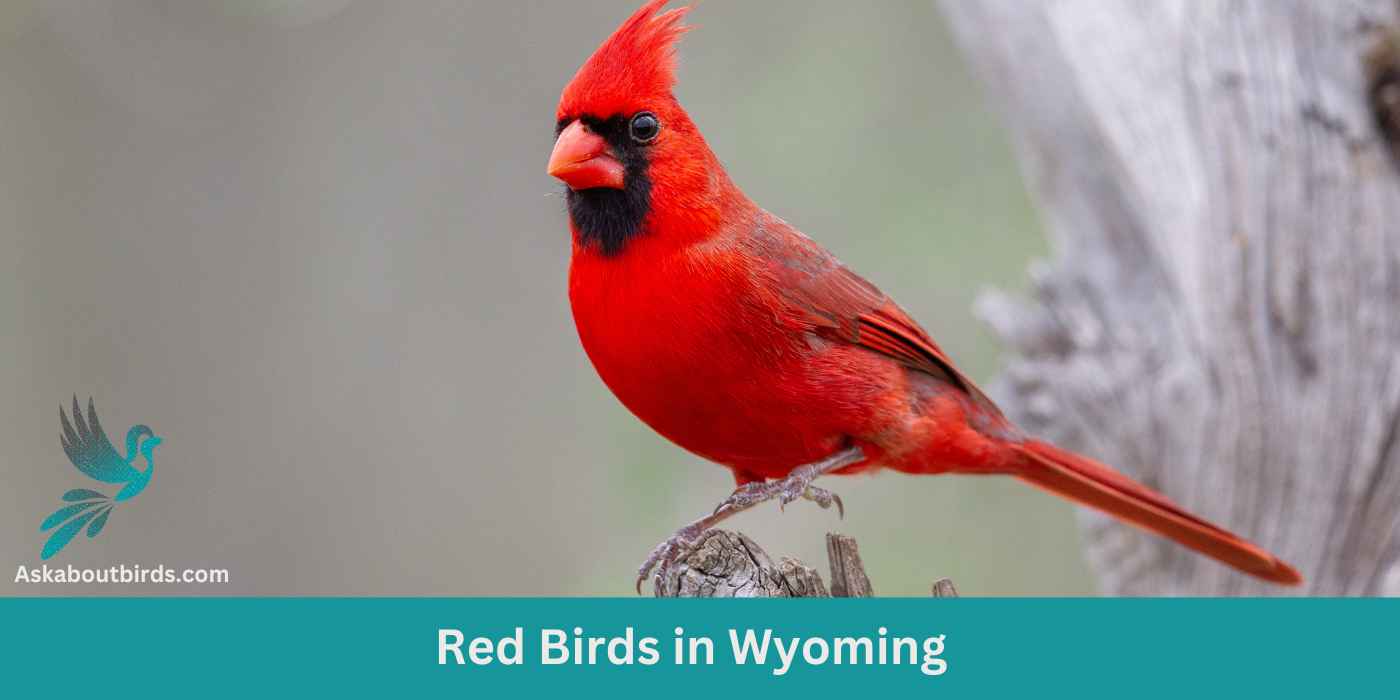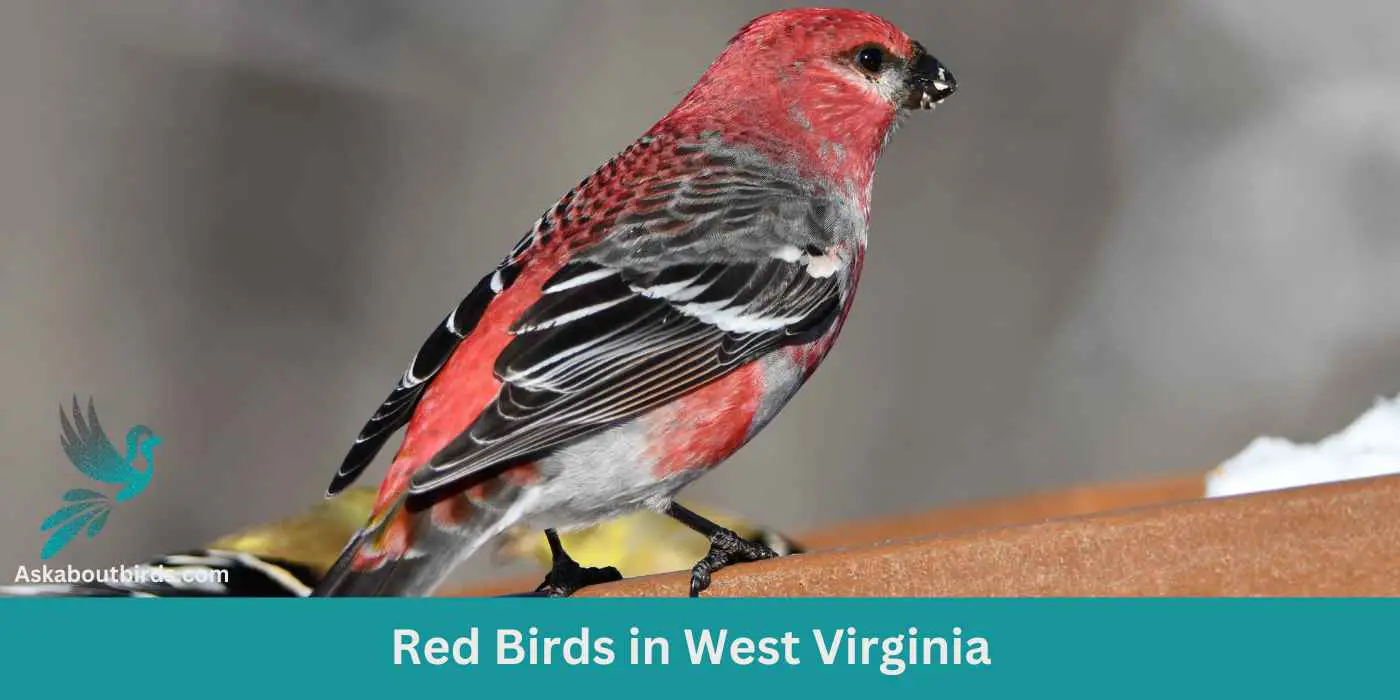Enriched with natural beauty, the landscapes of Arkansas harbor a captivating array of bird species, each bringing their own splash of color to The Natural State. Among them, eight distinctive birds stand out, casting a warm, orange hue across the Arkansas skies. Join us as we delve into the world of the Baltimore Oriole, Orchard Oriole, Northern Cardinal, American Redstart, Summer Tanager, Scarlet Tanager, Eastern Towhee, and the surprising eighth one.
Welcome to “8 Orange Birds in Arkansas,” where we celebrate these vibrant avian residents and their important roles in the state’s thriving ecosystems.
Orange Birds Found In Arkansas
Arkansas’s varied landscapes, ranging from dense forests and wetlands to highlands and mountainous terrains, provide diverse habitats, attracting an array of bird species, including those adorned in vibrant orange hues.
Scarlet Tanager


| Feature | Measurement |
|---|---|
| Scientific Name | Piranga olivacea |
| Length | 6.3 to 7.5 in |
| Wingspan | 9.8 to 11.8 in |
| Weight | 23.5 to 38 g |
The Scarlet Tanager is a strikingly colorful bird known for its brilliant plumage and distinctive song.
Appearance: Male Scarlet Tanagers are notable for their vibrant scarlet bodies contrasted with black wings and tail, making them one of the most intensely colored birds. Females and juveniles, on the other hand, have a subdued olive-yellow body color with darker wings and tail.
Diet: The diet of the Scarlet Tanager is largely made up of insects, including beetles, cicadas, aphids, and others. They are adept flycatchers, seizing insects in mid-air or picking them off foliage. They also consume fruits and berries, especially during migration and in their winter habitats.
Reproduction: The female Scarlet Tanager builds a cup-shaped nest using twigs, rootlets, and grass, typically well-hidden in the dense foliage of trees. She lays 3 to 5 eggs and incubates them for about two weeks.
Eastern Towhee

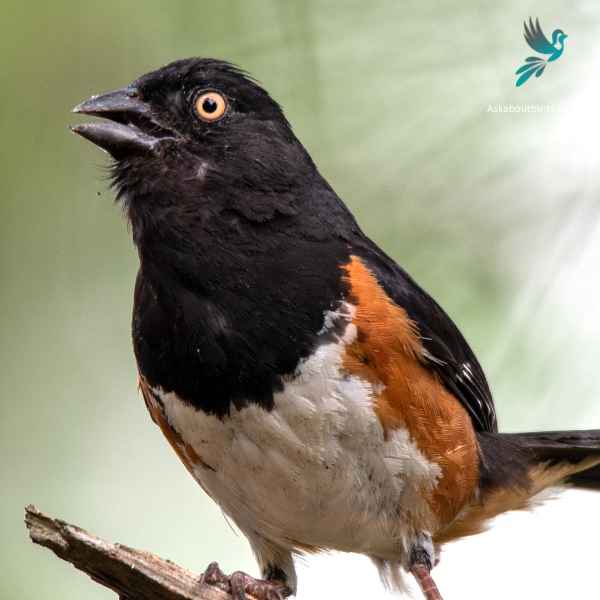
| Feature | Measurement |
|---|---|
| Scientific Name | Pipilo erythrophthalmus |
| Length | 6.8 to 9.1 in |
| Wingspan | 7.9–11.8 in |
| Weight | 32 to 53 g |
The Eastern Towhee is a distinctive songbird known for its unique calls and eye-catching coloration.
Appearance: Male Eastern Towhees are characterized by a striking combination of a black head, back and tail, contrasting with a white belly and rufous flanks. Females sport similar patterns but instead of black, they have a rich brown color. Both genders have red eyes, lending a special charm to their overall appearance.
Diet: Eastern Towhees primarily feed on a variety of insects, seeds, and berries. Their diet is quite diverse, taking advantage of seasonal offerings, which includes beetles, caterpillars, spiders, acorns, grass seeds, and various fruits and berries.
Reproduction: Eastern Towhees build their nests on or near the ground, often in a shrub or a small tree. The female lays around 3-5 eggs and takes the primary role in incubating them over about 12-13 days.
American Robins


| Feature | Measurement |
|---|---|
| Scientific Name | Leptotila plumbeicep |
| Length | 10.6-11.8 in |
| Wingspan | — |
| Weight | 160-200 g |
The American Robin is a widely recognized bird species known for its melodious song and early bird tendencies.
Appearance: American Robins are medium-sized birds with a distinctive appearance. Both males and females sport a gray to brown back and a warm red to orange breast and belly and gray wings. They also have a characteristic white eye-ring and a black head, but males are usually darker than females.
Diet: American Robins have a diverse diet that changes depending on the season. In summer, they feed heavily on earthworms, beetles, and other invertebrates, which they catch on the ground. During winter, they mostly eat fruits and berries.
Reproduction: American Robins usually build their nests in trees or shrubs, but they are also known to nest on human-made structures. The female lays a clutch of about 3 to 5 eggs, which she incubates for about 12 to 14 days.
Baltimore Oriole


| Feature | Measurement |
|---|---|
| Scientific Name | Icterus galbula |
| Length | 6.7–8.7 in |
| Wingspan | 9.1–12.6 in |
| Weight | 22.3-42 g |
The Baltimore Oriole is a stunning bird, best known for its vibrant coloration and its rich, whistling song.
Appearance: The male Baltimore Oriole is notable for his bright orange and black plumage and black and white wing bars, a stark contrast to the more muted yellow-brown coloration of the female. Both sexes, however, have long pointed bills and white bars on their wings.
Diet: Baltimore Orioles have a diverse diet that includes insects, fruits, and nectar. Their preference for sweet juices and fruit pulp often brings them to backyard feeders offering oranges and jelly.
Reproduction: The female Baltimore Oriole is responsible for building the distinctive hanging nest, often woven together from fine materials like hair and grass. These nests are usually high in trees to avoid predators. The female lays 3-7 eggs, which are incubated for about two weeks.
Orchard Oriole
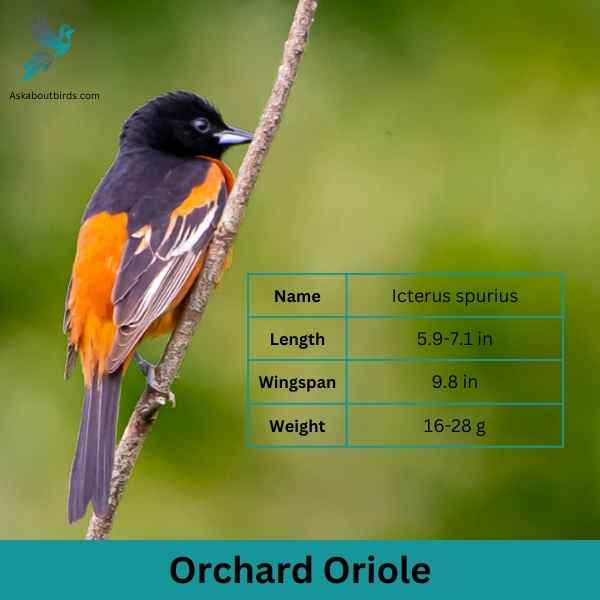
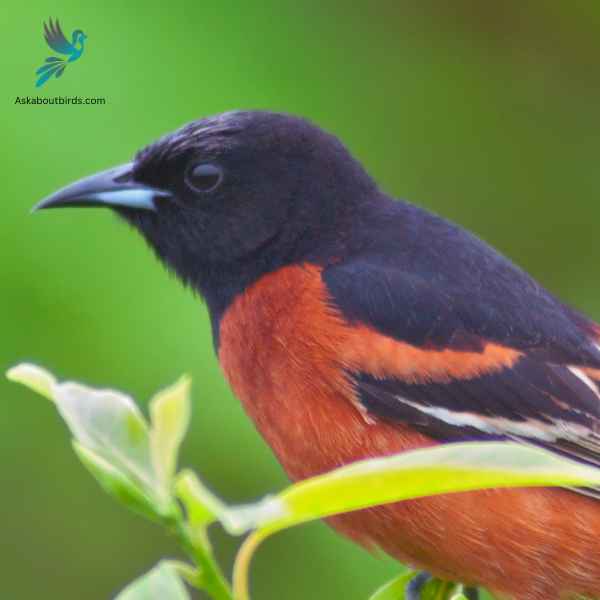
| Feature | Measurement |
|---|---|
| Scientific Name | Icterus spurius |
| Length | 5.9-7.1 in |
| Wingspan | 9.8 in |
| Weight | 16-28 g |
The Orchard Oriole is a small songbird noted for its distinctive coloration and melodic song.
Appearance: Male Orchard Orioles are a striking sight with their dark chestnut body and black head and black and white wings, while females and immature males are olive-green and feature a yellowish underpart. The species is often recognized by its slender body and pointed bill.
Diet: The diet of the Orchard Oriole consists primarily of insects, fruits, and nectar. They are adept at catching insects mid-air and are also known to sip nectar from flowers, aiding in pollination. When fruits are in season, they make up a substantial portion of the bird’s diet.
Reproduction: Orchard Orioles often nest in open woodlands and orchards, hence their name. The female is responsible for building the nest, typically choosing a location in a tree or shrub. The female lays a clutch of 4 to 6 eggs, which she incubates for about two weeks.
Northern Cardinal


| Feature | Measurement |
|---|---|
| Scientific Name | Cardinalis cardinalis |
| Length | 8.3 – 9.1 in |
| Wingspan | 9.8 – 12.2 in |
| Weight | 1.19 – 2.29 oz |
The Northern Cardinal is an iconic North American bird, easily recognized by its vibrant color and melodious song.
Appearance: Male Northern Cardinals are a brilliant scarlet red, while females display a more subdued reddish olive. Both sexes have a distinctive black ‘mask’ on their face around the bill and a pointed crest on their head. The bird’s beak is robust, cone-shaped, and bright orange in color.
Diet: Northern Cardinals are primarily granivorous, with a diet largely consisting of seeds and grains. They also eat fruits and insects. These birds typically feed off the ground and are frequent visitors to bird feeders.
Reproduction: Northern Cardinals are monogamous, and a pair will breed together for life. The female typically builds a well-hidden nest in a dense thicket or shrub. She lays 2-5 eggs per clutch, which she incubates for around two weeks.
American Redstart


| Feature | Measurement |
|---|---|
| Scientific Name | Setophaga ruticilla |
| Length | 4.3 to 5.5 in |
| Wingspan | 6.3 to 9.1 in |
| Weight | 8.6 g |
The American Redstart is a lively warbler known for its vivid colors and active hunting style, often seen flitting about, fanning its tail to startle and catch insects.
Appearance: Adult male American Redstarts boast striking black plumage with bright orange patches on the sides, wings, and tail. Females and immature males have grayish-olive upperparts with yellow patches in the same areas where the males display orange.
Diet: American Redstarts are primarily insectivores. They actively forage for flying insects, as well as caterpillars and spiders, often using their colorful tails to startle prey and make them easier to catch.
Reproduction: The female American Redstart builds a cup-shaped nest in the fork of a tree branch. Typically, she lays a clutch of 3 to 5 eggs. The female takes on the primary responsibility of incubating the eggs, while both parents participate in feeding the fledglings after they hatch.
Summer Tanager


| Feature | Measurement |
|---|---|
| Scientific Name | Piranga rubra |
| Length | 6.7 in |
| Wingspan | 28 to 30 cm |
| Weight | 29 g |
The Summer Tanager is a medium-sized songbird admired for its radiant plumage and melodious song.
Appearance: Male Summer Tanagers are an impressive bright red, while females and juveniles present a softer, yellow-orange color. Both genders have a large, slightly hooked bill and relatively short tail.
Diet: Summer Tanagers primarily feed on insects, including bees and wasps, which they catch in flight or pick off vegetation. They are also known to eat fruits and berries, making them helpful in controlling pest populations and seed dispersal.
Reproduction: The female Summer Tanager builds a loose, shallow cup-shaped nest out of twigs and grass, usually hidden in the foliage of trees. The female typically lays 3-5 eggs, which she will incubate for about two weeks.
Where to Spot Arkansas’s Orange Birds
The enchanting landscapes of Arkansas offer a rich tapestry of habitats that attract a diverse array of bird species, including those with brilliant orange plumage. For those seeking to experience this bird-watching paradise, here are the top spots you won’t want to miss:
- Holla Bend National Wildlife Refuge – A haven for waterfowl and migratory birds, Holla Bend provides excellent opportunities to spot Orioles and Tanagers amidst its wetlands and forests.
- Hot Springs National Park – This park’s forested hillsides are a favorite haunt of the Northern Cardinal and Eastern Towhee, making it a must-visit location for any bird enthusiast.
- Buffalo National River – This area is renowned for its diverse bird life. The riparian environments along the river offer ideal conditions for many bird species, including the American Redstart.
- Wapanocca National Wildlife Refuge – Nestled in the Mississippi River Valley, this refuge hosts a plethora of bird species, providing excellent bird-watching opportunities year-round.
These locations, steeped in natural beauty, offer a feast for the eyes and the soul, promising not just birdwatching but an immersive experience with nature.
| State’s Orange Birds | Best Spots to See Orange Birds |
|---|---|
| Missouri’s Orange Birds | Ozark National Scenic Riverways, Mingo National Wildlife Refuge, Mark Twain National Forest |
| Tennessee’s Orange Birds | Great Smoky Mountains National Park, Radnor Lake State Park, Reelfoot Lake State Park |
| Mississippi’s Orange Birds | Noxubee National Wildlife Refuge, Gulf Islands National Seashore, DeSoto National Forest |
| Louisiana’s Orange Birds | Atchafalaya National Wildlife Refuge, Jean Lafitte National Historical Park, Sabine National Wildlife Refuge |
| Texas’s Orange Birds | Aransas National Wildlife Refuge, Big Bend National Park, High Island for Spring Migration |
| Oklahoma’s Orange Birds | Wichita Mountains Wildlife Refuge, Sequoyah National Wildlife Refuge, Salt Plains National Wildlife Refuge |
FAQs on Orange Bird Species Found in Arkansas
What kind of bird is orange in color?
Among the various species, the Eastern Bluebird stands out with its vibrant orange hue contrasted with dark blue. These birds, often seen perched or visiting bird feeders, especially when offered black oil sunflower seeds, present a delightful sight with their mix of brilliant colors.
What birds are light orange?
House Finches display a light orange to rusty orange coloration, particularly the males. Their feathers can range from bright yellow to a more subdued light brown, and they’re often found with white wing bars. Regular visitors to bird feeders, they enjoy a variety of seeds and are a common sight in many backyards.
How long do Orioles stay in Arkansas?
Orioles, known as orange and black birds, migrate to Arkansas as winter birds primarily for the warmer months. While their exact stay can vary based on factors like weather and food availability, they generally arrive in spring and depart by late summer. During their stay, it’s not uncommon to see them visit bird feeders, especially when filled with their favorites like black oil sunflower seeds.
What kind of bird is orange and brown?
The Eastern Bluebird, with its unique blend of dark blue, bright yellow, and grayish-brown, can sometimes give an impression of being orange and brown. Additionally, the Blue Grosbeak, another species, showcases a mix of blue and light brown, making them a captivating sight for bird enthusiasts. In Arkansas, among the Blue Jay, House Finch, and Dark-eyed Junco, only the House Finch exhibits an orange hue. The House Finch males can showcase a light to rusty orange coloration. In contrast, Blue Jays are primarily known for their bright blue feathers, and Dark-eyed Juncos exhibit a blend of gray and white plumage. While there are other birds in Arkansas with striking orange coloration, these specific species each have their unique and distinguishing colors.


